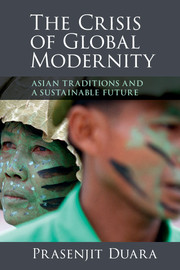Book contents
- Frontmatter
- Epigraph
- Contents
- List of figures and maps
- Preface and Acknowledgements
- Introduction
- 1 Sustainability and the crisis of transcendence
- 2 Circulatory and competitive histories
- 3 The historical logics of global modernity
- 4 Dialogical and radical transcendence
- 5 Dialogical transcendence and secular nationalism in the Sinosphere
- 6 The traffic between secularism and transcendence
- 7 Regions of circulation and networks of sustainability in Asia
- Reprise and Epilogue: of reason and hope
- Bibliography
- Index
- References
5 - Dialogical transcendence and secular nationalism in the Sinosphere
Published online by Cambridge University Press: 05 January 2015
- Frontmatter
- Epigraph
- Contents
- List of figures and maps
- Preface and Acknowledgements
- Introduction
- 1 Sustainability and the crisis of transcendence
- 2 Circulatory and competitive histories
- 3 The historical logics of global modernity
- 4 Dialogical and radical transcendence
- 5 Dialogical transcendence and secular nationalism in the Sinosphere
- 6 The traffic between secularism and transcendence
- 7 Regions of circulation and networks of sustainability in Asia
- Reprise and Epilogue: of reason and hope
- Bibliography
- Index
- References
Summary
When religious systems began to cease legitimating political structures over the last few hundred years, they were replaced, ultimately and in most cases, by secular nationalisms. After an extended period of religious wars in Europe from the sixteenth to the early eighteenth century, the Europeans, according to a broad understanding of secularism, brought religion under an enlarged state order and sought to protect minorities from majority religious groups, and, ideally, from the state itself. While much of this narrative may still hold, the complex and implication-laden history of the transition in its global context is still poorly understood. As we will see, nationalism inherited and reconfigured confessional polities rather than rejected or annulled religious politics in Latin Europe. As a kind of secularized confessionalism, the nation became an engine of conquest over peoples and nature.
Although the details of this transition are obscure, nationalists, reformers and leaders in Asian societies began to recognize the importance of both confessional nationalism and secularism in order to resist and compete with the Western powers from the late nineteenth century. In this chapter, I explore these processes in East Asia, where institutionalization was less affected by direct colonial rule than the rest of Asia (examined in Chapter 6). In order to track the impact of these forces, I will explore the changing relationship between state and religions in late imperial China, focusing mostly on the Qing period (1644–1911). I also examine the impact on segments and groups in Chinese popular religion who accommodated diversity by modes of dialogical transcendence. What became of the techniques of self-formation linking the self/body (shen) to the local and to universal ideals in late imperial China?
- Type
- Chapter
- Information
- The Crisis of Global ModernityAsian Traditions and a Sustainable Future, pp. 156 - 194Publisher: Cambridge University PressPrint publication year: 2014
References
- 1
- Cited by



